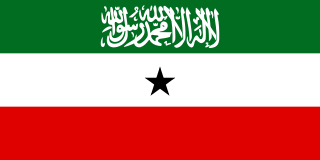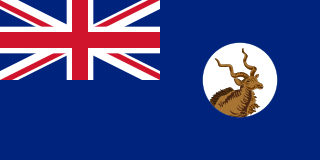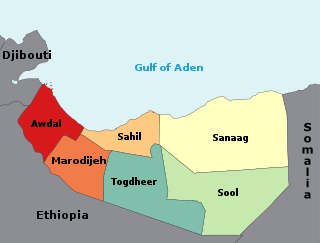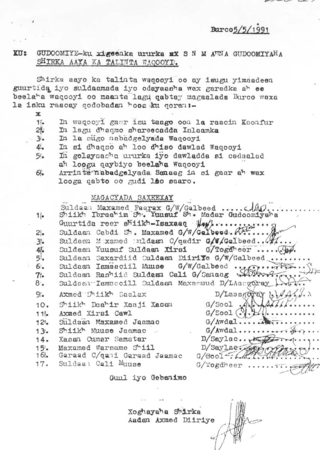See also
- History of Somalia
- Flag of Somalia
- Soomaaliyeey toosoo, national anthem 2000–2012
- Qolobaa Calankeed, national anthem 2012–present
| English: National anthem of Somalia | |
|---|---|
Former national anthem of Somalia | |
| Music | Giuseppe Blanc |
| Adopted | July 1, 1960 |
| Relinquished | 2000 |
| Succeeded by | "Soomaaliyeey toosoo" |
| Audio sample | |
The National Anthem of Somalia (Somali : Astaanta Qaranka Soomaaliya) was the national anthem of Somalia between 1960 and 2000.
The Somali Republic was formed on 1 July 1960 following the union of the newly independent Trust Territory of Somalia (the former Italian Somaliland, now Somalia) and the State of Somaliland (the former British Somaliland, now Somaliland). At this time a wordless and untitled piece by Italian composer Giuseppe Blanc was adopted as the national anthem. [1] [2] This anthem remained in use during the Somali Democratic Republic period between 1969–1991. It was replaced with Soomaaliyeey toosoo by the Transitional national government of Somalia in 2000.

Somaliland, officially the Republic of Somaliland, is an unrecognised country in the Horn of Africa. It is located in the southern coast of the Gulf of Aden and bordered by Djibouti to the northwest, Ethiopia to the south and west, and Somalia to the east. Its claimed territory has an area of 176,120 square kilometres (68,000 sq mi), with approximately 6.2 million people as of 2024. The capital and largest city is Hargeisa.

British Somaliland, officially the Somaliland Protectorate, was a protectorate of the United Kingdom in modern Somaliland. During its existence, the territory was bordered by Italian Somalia, French Somali Coast and Abyssinia. From 1940 to 1941, it was occupied by the Italians and was part of Italian East Africa.

The national flag of Somalia was adopted on October 12, 1954, and was designed by Mohammed Awale Liban. The flag was initially used within the Trust Territory of Somaliland before being adopted by the short-lived State of Somaliland and the Somali Republic. It is an ethnic flag for the Somali people; the flag's five-pointed star represents the five regions in which Somalis reside.

Greater Somalia sometimes also called Greater Somaliland is the geographic location comprising the regions in the Horn of Africa in which ethnic Somalis live and have historically inhabited.

The flag of Somaliland was adopted on 14 October 1996. It consists of a tricolour of green, white, and red, with a black star located in the centre. On the green stripe, there is the Shahada in white calligraphic script.

The regions of Somaliland is divided into six administrative regions, Awdal, Sahil, Maroodi-Jeeh, Togdheer, Sanaag and Sool. These are in turn subdivided into twenty-two districts. Regions of Somaliland are the primary geographical divisions through which Somaliland is administered. A distinction is made between districts of grades A, B, C and D, with the classification being based on population, area, economy and production.

Mohamed Ibrahim Warsame, known by the pseudonym Hadrawi, was a Somali poet, philosopher and songwriter. Having written many notable protest works, Hadrawi has been likened by some to Shakespeare, and his poetry has been translated into various languages.

Somaliland, officially the State of Somaliland, was a short-lived independent country in the territory of the present-day unilaterally declared Republic of Somaliland, which regards itself as its legal successor. It existed on the territory of former British Somaliland for five days between 26 June 1960 and 1 July 1960, when it merged with the formerly Italian administered Trust Territory of Somaliland to form the Somali Republic.

The national emblem of Somaliland, was introduced on 14 October 1996 along with the flag of Somaliland, when it was approved by the National Conference. It was introduced by Abdullahi Abdi Omar (Jawaan).

The Trust Territory of Somaliland, officially the "Trust Territory of Somaliland under Italian administration", was a United Nations Trust Territory from 1950 to 1960, following the dissolution of the former British Military Administration. It was administered by Italy before gaining independence. It covered most of present-day Somalia and its capital was Mogadishu.

The Somaliland Scouts was a Rayid military unit, a regiment, of the British Army. It was established after the liberation of British Somaliland from Italy in December 1941 and the dissolution of the Somaliland Camel Corps in 1942, which was formerly tasked with the defense of the protectorate.

The following outline is provided as an overview and topical guide to Somaliland:

Italian Somalis are Somali-born citizens who are fully or partially of Italian descent, whose ancestors were Italians who emigrated to Somalia during the Italian diaspora, or Italian-born people in Somalia. Most of the Italians moved to Somalia during the Italian colonial period.

The following is a survey of the postage stamps and postal history of Somalia. From the late 1800s to 1960, northwestern present-day Somalia was administered as British Somaliland, while the northeastern, central and southern part of the country were concurrently administered as Italian Somaliland. In 1960, the two territories were unified as the Somali Republic.
During its modern history, various national symbols have come to represent Somalia. Due to the country's instability, many of these are only used in areas under the Federal Government of Somalia, and may not apply to breakaway regions such as Somaliland.

Haji Bashir Ismail Yusuf, commonly referred to as Haji Bashir, was a Somali politician. He was a prominent Somali Youth League (SYL) member and the first President of the Somali National Assembly during the Somali Republic's early civilian administration.
"Qolobaa Calankeed" is the national anthem of Somalia. Written and composed by Abdullahi Qarshe, it was adopted on 1 August 2012 with the passage of the Somali national constitution, in which it is enshrined. It replaced "Soomaaliyeey toosoo", which had been in use since 2000. "Soomaaliyeey toosoo" is often still used as a de facto national anthem, though the official national anthem for Somalia is "Qoloba Calankeed".

Somalia–United Kingdom relations are bilateral relations between Somalia and the United Kingdom.

Somali nationality law is regulated by the Constitution of Somalia, as amended; the Somali Citizenship Law, and its revisions; and various international agreements to which the country is a signatory. These laws determine who is, or is eligible to be, a national of Somalia. The legal means to acquire nationality, formal legal membership in a nation, differ from the domestic relationship of rights and obligations between a national and the nation, known as citizenship. Nationality describes the relationship of an individual to the nation under international law, whereas citizenship is the domestic relationship of an individual and the state. Somali nationality is typically obtained under the principle of jus soli, i.e. by birth in Somalia, or jus sanguinis, born to parents with Somali nationality. It can be granted to persons with an affiliation to the country, or to a permanent resident who has lived in the country for a given period of time through grant (naturalization).

The Somaliland Declaration of Independence was made on 18 May 1991 by Somali sultans from the Isaaq, Dhulbahante, Issa, Gadabursi, Warsangali clans, as well as the Somali National Movement.